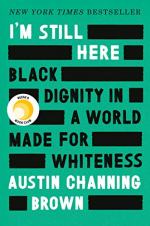|
This section contains 838 words (approx. 3 pages at 400 words per page) |

|
I'm Still Here Summary & Study Guide Description
I'm Still Here Summary & Study Guide includes comprehensive information and analysis to help you understand the book. This study guide contains the following sections:
This detailed literature summary also contains Topics for Discussion on I'm Still Here by Austin Channing Brown.
The following version of this book was used to create this study guide: Brown, Austin Channing. I'm Still Here: Black Dignity in a World Made for Whiteness. New York: Convergent Books, 2018.
Austin Channing Brown opens the book by recalling an incident from childhood in which a librarian questioned the name on her library card. She asked her mother why her parents had chosen this name for her. Her mother responded that they picked a name traditionally associated with white men because they wanted to make sure that when she applied for jobs, she would at least be granted an interview.
Brown goes on to narrate a typical series of events when she starts a new job. A co-worker often tells her that she should come to them if she experiences any racism in the workplace, but when she does exactly that, the co-worker suggests she is being too sensitive or misunderstanding the situation. She explains that she wrote I'm Still Here to describe how she came to embrace her identity as a Black woman despite living in America, where “white is right” (23).
In Chapters 2-4, Brown recalls her youth and education. She attended predominantly white schools where the notion of “racial harmony” (51) was promoted, but the white students still frequently displayed racial insensitivity. When Brown was 10, her parents divorced, and her mother moved to a predominantly Black neighborhood in Cleveland. Brown was teased by the other children for her stereotypically white mannerisms. She developed a close friendship with a girl named Tiffani who helped her see that “Black is beautiful whether it looked nerdy like me or cool like her” (34). Brown also began attending a predominantly Black church with her father and stepmother around this time, and this experience prompted a lifelong commitment to the Christian faith.
After college, Brown began working for Christian non-profit organizations, helping to facilitate diversity initiatives. She provides examples of microaggressions she has experienced at work, such as having her hair touched without permission and having her ideas ignored during a meeting until they were repeated, almost verbatim, by a white co-worker. She writes of the importance of maintaining self-confidence and morale despite the challenges inherent in being a Black person in a predominantly white workplace.
In Chapters 6-7, Brown describes some of the specific ways white people react to racism that she views as harmful to the cause of racial justice. The term “white fragility” (85) refers to a white person centering their own feelings, usually of anger, sadness, or remorse, in a situation where racism is being discussed. As an example, Brown recalls doing mission work for an organization that brought white Christian youth groups into a predominantly Black neighborhood in Chicago to learn about experiences outside of their own. One tour group reacted to the neighborhood with fear and expressed anger about feeling unsafe. Consequently, they left the tour having learned nothing. A second tour group was more open to the experience and after the tour was over, Brown heard a young girl having a conversation with her father about the importance of getting to know someone rather than judging them based on their skin color.
In Chapters 8-9, the author states that America has failed to truly reckon with the atrocities of its racist history, and that channeling one's anger about racial injustice into a creative endeavor, such as writing, can be beneficial.
In Chapters 10-11, Brown writes of her cousin Dalin, who was the victim of a robbery as a teenager and went on to sell drugs. Dalin was arrested several times and assaulted by police, then given a 10-year prison sentence because of the 'three strikes' provision of the Violent Crime Control and Law Enforcement Act. While in prison, he was struck by lightning when his unit was left outside in the yard during a thunderstorm. Incidents like this make the author fearful of the possibility that other Black men in her life, such as her husband and son, could become the victims of police brutality or other acts of systemic racial violence and neglect.
In Chapter 12, Brown explores the continuity of racial injustice in America, explaining how little things have changed from the era of the Civil Rights Movement to the present. Black people are still victimized by police brutality and white supremacist violence. In Chapter 13, she discusses the inadequacy of many “racial reconciliation” (165) programs in religious institutions, which aim to facilitate equity and diversity within churches. She believes that promoting more Black people into leadership positions and engaging in racial justice activism as a congregation would be more effective methods of achieving these goals.
In Chapter 13, Brown explains the challenge of maintaining hope in the potential for racial justice. Despite the prospect often seeming impossible, she feels she must continue to believe in and pursue it. “It is the culmination of everything my ancestors endured, of all that my parents taught me, of the Blackness that rescued me,” she writes, “How dare I consider surrender simply because I want the warmth of the sun?” (182).
Read more from the Study Guide
|
This section contains 838 words (approx. 3 pages at 400 words per page) |

|



